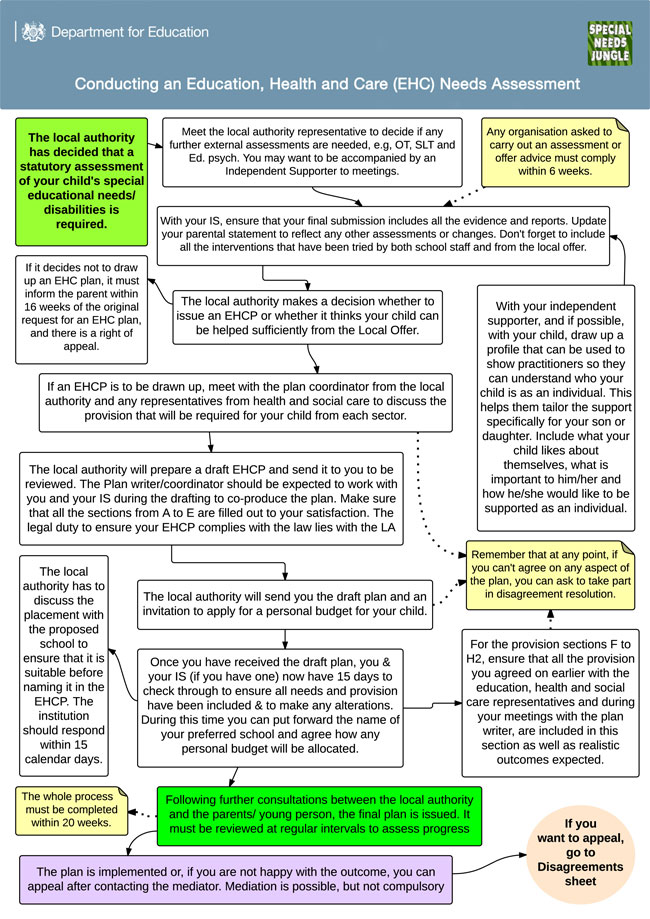STEP THREE: PLANNING
The planning stage of the EHCP journey involves taking all of the information found from the assessments and, where these find that more support is needed, putting this into a plan template.
WHAT DID PARENTS TELL US ABOUT PLANNING?
What this step involves
The plan sets out:
(A) The views, interests and aspirations of the child and their parents, or of the young person (B) The child or young person’s special educational needs (SEN) (C) The child or young person’s health needs which relate to their SEN (D) The child or young person’s social care needs which relate to their SEN (E) The outcomes sought for the child or the young person (F) The special educational provision required by the child or the young person (G) Any health provision reasonably required by the learning difficulties or disabilities which result in the child or young person having SEN (H1) Any social care provision which must be made for a child or young person under 18 resulting from section 2 of the Chronically Sick and Disabled Persons Act 1970 (CSDPA) (H2) Any other social care provision reasonably required by the learning difficulties or disabilities which result in the child or young person having SEN (I) Placement (only added to the Final version) (J) Personal Budget (including arrangements for direct payments) (K) Advice and information A draft plan is shared with parents for them to agree or suggest changes. Once agreed it is then re-issued including placement details (ie the school named) and this is the Final Plan Our research shows this step may involve:
- capturing the child or young person and families story, and setting out their aspirations often via parents;
- assembling all of the evidence (from reports, assessments, opinions) into one document – the plan
- setting out what the tf rolex datejust mens 116285 rolex calibre 2813 gold tone child’s identified needs are;
- detailing the support the child/young person and family will receive;
- specifying outcomes and resources;
- negotiation – e.g. of placement and of the resource required to address the child’s specified needs;
- a multiagency meeting to agree plan content
- a decision being made on placement which is then added to the final plan
- signing off the final plan
What the code of practice says
Click here to read the document online 9.53 Where, in the light of an EHC needs assessment, it is necessary for special educational provision to be made in accordance with an EHC plan, the local authority must prepare a plan. Where a local authority decides it is necessary to issue an EHC plan, it must notify the child’s parent or the young person and give the reasons for its decision. The local authority should ensure it allows enough time to prepare the draft plan and complete the remaining steps in the process within the 20-week overall time limit within which it must issue the finalised EHC plan. 9.77 The local authority must send the draft EHC plan (including the appendices containing the advice and information gathered during the EHC needs assessment) to the child’s parent or to the young person and give them at least 15 days to give views and make representations on the content. During this period, the local authority must make its officers available for a meeting with the child’s parent or the young person on request if they wish to discuss the content of the draft EHC plan. When the local authority sends the draft EHC plan to the child’s parent or the young person the following apply:
- The local authority must notify the child’s parent or the young person that during this period they can request that a particular school or other institution, or type of school or other institution, be named in the plan. The draft plan must not contain the name of the school, maintained nursery school, post-16 institution or other institution or the type of school or other institution to be attended by the child or young person (see below)
- The local authority must advise the child’s parent or the young person where they can find information about the schools and colleges that are available for the child or young person to attend, for example through the Local Offer
- The local authority should also seek agreement of any Personal Budget specified in the draft plan (see paragraph 9.95 onwards for more information on Personal Budgets)
9.125 When changes are suggested to the draft EHC plan by the child’s parent or the young person and agreed by the local authority, the draft plan should be amended and issued as the final EHC plan as quickly as possible. The final EHC plan can differ from the draft EHC plan only as a result of any representations made by the child’s parent or the young person (including a request for a Personal Budget) and decisions made about the school or other institution (or type of school or other institution) to be named in the EHC plan. The local authority must not make any other changes – if the local authority wishes to make other changes it must re-issue the draft EHC plan to the child’s parent or the young person (see paragraph 9.77). The final EHC plan should be signed and dated by the local authority officer responsible for signing off the final plan. 9.129 As well as the child’s parent or the young person, the final EHC plan must also be issued to the governing body, proprietor or principal of any school, college or other institution named in the EHC plan, and to the relevant CCG (or where relevant, NHS England).
Parents want …
Plans to be well-structured
- They valued the ethos and structure of the EHC plan; that it covers their aspirations, the outcomes to achieve and how these will be met.
- Plans are large documents that need to be made clear and accessible to a wide audience.
- Draft plans are not always easy to read and can include a lot of technical information and jargon that is hard to read and understand
The child/young person's views included
- Where the wishes and feelings of the child/young person and family are well-captured in the plan, parents really appreciate it, and are more likely to see the document as ‘theirs’. It helps to ensure their concerns, desires and circumstances are captured and listened to.
- Parents expressed concerns when their opinions/experiences were not given equal weight to those of professionals.
- Parents often wanted their voice to be used as the proxy for the child
Time to consider and amend plans
- They valued being able to contribute and make changes to the draft plan. They feel it is explained to them well that they can suggest changes, although there is uncertainty about what can be changed (can a parent alter the amount or type of support for example)
- Agreeing the draft plan can affect the timescales. Parents told us delays occur as they work with LAs to improve the drafting, content and (SMART) resource specified in the plan.
- If parents had not seen another plan before then they might be agreeing to draft content without knowing whether that is what the plan should contain. Some are worried that they are signing off a substandard plan without realising it
Needs, Actions and Provision specified
- They want a plan that:
- is explicit about the needs and abilities of their child/young person
- includes ‘SMART’ targets [insert link to definition?]
- documents actions required to address the needs stated
- specifies clear outcomes with reasonable timescales and
- specifies the resources required to address them.
- Their plans are often a statement of the child’s needs or condition. They can lack detail of the educational, health and social implications of these and the support required.
Health and Social care provision is Lacking
- Plans with appropriate input from health and social care practitioners were seen as much more beneficial, holistic and useful than those without.
- Appropriate means that the practitioners explain what the issue they work with the child on means in term of educational support needs (e.g. not just that the child has X condition, but that they will need help with reading, struggle to concentrate, etc)
Wider family support needs addressed
- The holistic needs of the family are often lacking with limited support offered to help address those.
- The wider support needs of the family – in terms of financial, emotional and physical needs are lacking.
- The process of compiling a plan often makes families to consider the future in ways they had not done before – future aspirations for their child etc. They needed help and support.
- Plans to provide education support could be different to those being offered to the family elsewhere (for example through other agencies such as CAMHS).
Plans to aim high
- Educational expectations and aspirations are felt to be generally low for children with SEND.
- Assessments required to inform the plan may focus on the child’s deficits as opposed to achievements and aspirations.
- They can focus too much on emotional or behavioural development without clear educational attainment targets
Consistent plan quality
- Draft plans are either well-written and structured and based on evidence – OR a “copy and paste” of assessments, reports and emails
- Draft plans are better when they were tailored to the individual child rather than generic. Parents don’t like it when content is copied and pasted from other children’s plans!
- Different opinions and conflicting advice can be contained in the plan
- The extent to which the provision and responsibilities for support in the plan are Specific, Measureable, Attainable , Realistic and Timely (SMART) is variable. Sometimes their plans differ in quality from those of other families including in the same area (in terms of the extent to which actions and resources to meet their child’s needs were SMART.)
- They want a plan that is comprehensive. They want assessment information, family and professional input pulled together to form a cohesive story, with clear actions and outcomes.
- Some professionals struggle to identify appropriate outcomes or be sufficiently aspirational about children
Co-produced plans
- Ownership of the Plan is important for parents.
- They like draft plans co-produced with multi-agency teams at regular meetings. Parents valued this approach.
- In other cases, draft plans were written remotely and were not an accurate reflection of the discussions that had taken place. Some content can come as a surprise to parents, which is distressing and disempowering
A clear process for signing off and agreeing the final plan
- They feel able to comment on draft plans and these are being taken on board in the production of the final draft.
- Agreeing the final plan can be a protracted and stressful process.
- Holding a meeting to go through the content of the draft plan were valued. These were better when the family had had sight of the plan in advance
- They need time to go through the draft plan and to make suggested alterations in their own time. The plan contains big decisions which they want to fully consider
- They enjoyed the collaborative nature of the assessment process. However, they hadn’t appreciated the implications of signing the plan until they started to consider/experience what this meant in actual terms for the support their child/young person would receive at their placement.
- Provision stated on a plan may be contested by the placement named on the plan – as the placement provider (e.g. school) negotiated financial resource with the LA. This is stressful for parents – and a difficult end to what may have been a positive process up until that point.
Agreed placement specified
- Placement decisions specified in the final plan are still coming as a surprise to parents, even when they have been involved in the process and it has felt collaborative throughout.
- Placement decisions taken by a panel do not always reflect discussions that have taken place during the course of drafting the plan.
- Parents are having to think about appropriate educational placements for their child as a result of needs identified. Parents needed time to visit schools and to make an informed choice regarding their preferences.
- They value an independent person accompanying them to school visits.
- Placements stated on the plan are not always agreed by the named placement, resulting in delays and stressful negotiations.
- Involving the preferred placement provider in early discussions about the needs of the child and the support required, helped to circumvent concerns/discussions about who would provide it once the plan had been agreed and set up strong and trusting relationships between the family and providers
- The point at which placement decisions are being discussed during plan production are blurred. For some, this is during the drafting stage. For others this is not until the final plan is issued. For some this is being negotiated after the plan has been signed.
High quality Post-16 provision
- Post-16 provision does not necessarily mean the child attending the institution full-time. This causes family concerns regarding the young person’s care when they are not at the provider.
- Provision is not always appropriate, progressive and aspirational.
- It is not effectively preparing them for life and work.
- Work placements as part of College provision are limited.
Personal Budgets meaningfully discussed
- Only some said they had been told about them during the EHC process but hadn’t been able to ‘take it in’ or consider what it meant.
- They did not believe they were eligible for a personal budget as they were under the impression that they did not apply in their area, or for children of their age.
- They had not heard of a personal budget or direct payments.
- Those who had heard of personal budgets thought it meant them taking responsibility for all the money spent on their child (ie direct pay) and found this daunting
- There was no appreciation that seeing a personal budget goedkope Cbd eetwaren could help inform decisions, even though many parents suspected decisions they disagreed with had been taken due to funding issues
Read family stories …
PRACTITIONER CHECKLIST
Practical Steps to Help Parents Through the Planning Step
CHECK YOUR PLANNING PROCESS
Good Practice
Service 1 has a team of experienced SEN caseworkers. They are allowed to arrange placements without any decision having to go through a decision Panel. This happens when provision is clear and straightforward, with consensus amongst the multiagency team and no issue with placement availability. Therefore only contentious cases or those where provision would be beyond the normal resource need or where potential places are not available go through the panel process. This allows consistency between the multiagency discussions and final placement outcomes and means that the SEN caseworker an be building up an opinion on placement with the parents and professionals whilst drafting the plan.
Service 3 hold multiagency meetings after assessment where collaboratively they write the contents of the draft plan. This ensures agreement across the team and with parents. It means that parents remain involved in the process and are aware of all the discussions taking place, the implications of the findings from their child’s assessments and their level of need and required support.
Service 2 have used transition funding to employ two team members as Plan Writers. These staff take all of the information from professional reports, as well as family inputs and present them appropriately in the plan template. They check any information which is not clear and ensure plans are accessible and meaningful. This means there is a consistency across all plans and professionals’ time (especially that of SEN caseworkers) is freed up from having to produce appropriate content themselves.





